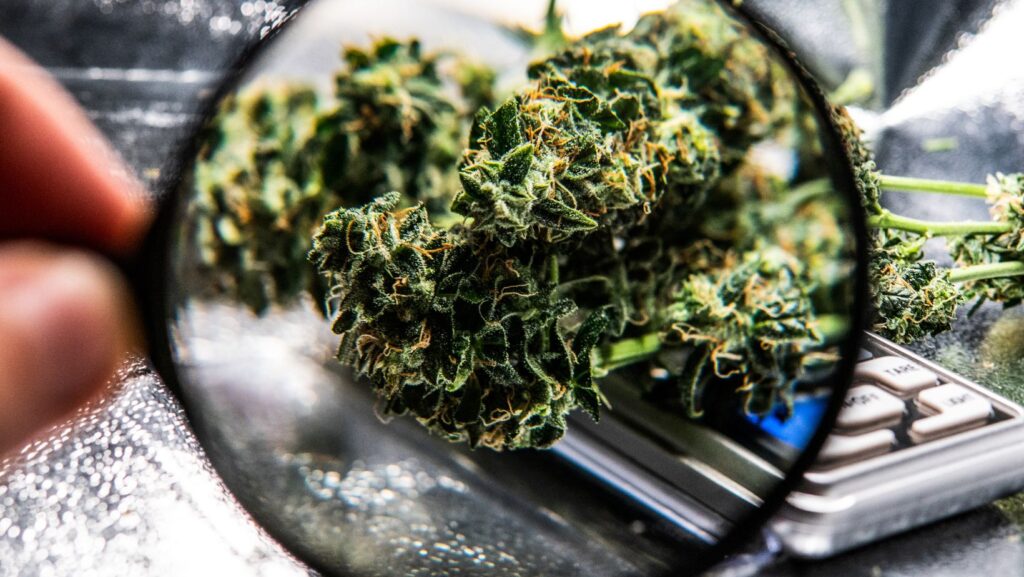Anxiety affects millions of people worldwide, prompting many to seek natural remedies to manage their symptoms.
Among these remedies, cannabis has emerged as a popular option. Certain weed strains are known to help reduce anxiety, but how exactly do they work? Understanding the science behind weed strains and their effects on anxiety can help you make informed choices about using cannabis for anxiety relief.
How Cannabis Affects the Brain
The Endocannabinoid System
The endocannabinoid system (ECS) regulates an important physiological activity that includes mood, appetite, pain, and stress response. Endocannabinoids, naturally occurring substances in the body, cannabinoid receptors (CB1 and CB2), and the enzymes that degrade them make up the endocannabinoid system (ECS).
Interaction with Cannabinoid Receptors
When you consume cannabis, cannabinoids such as THC (tetrahydrocannabinol) and CBD (cannabidiol) interact with the ECS. THC binds primarily to CB1 receptors in the brain, producing psychoactive effects and altering mood and perception. Conversely, CBD interacts with both CB1 and CB2 receptors more indirectly, influencing the ECS without causing a high.
Key Cannabinoids for Anxiety Relief
THC and Anxiety
Psychoactive substances like THC are well-known for their ability to affect anxiety in both positive and bad ways. THC can cause euphoria and relaxation at modest doses, which may lessen anxiety. Higher dosages of THC, however, may cause some people to become more paranoid and anxious. When utilizing THC for anxiety treatment, it’s crucial to strike the correct balance because of these two effects.
CBD and Anxiety
CBD is non-psychoactive and has gained attention for its potential therapeutic benefits. Research suggests that CBD can help reduce anxiety by interacting with serotonin receptors in the brain, which are involved in regulating mood and anxiety. CBD may also enhance the activity of GABA, a neurotransmitter that promotes relaxation and reduces stress.
The Role of Terpenes in Anxiety Reduction
What Are Terpenes?
Terpenes are aromatic compounds found in cannabis and other plants. They contribute to the distinct smell and flavor of different weed strains.

Beyond their sensory effects, terpenes also have various therapeutic properties.
Terpenes and Their Effects on Anxiety
- Limonene: Found in citrus fruits, limonene has a bright, citrusy aroma and is known for its mood-elevating and anxiety-reducing effects.
- Linalool: Present in lavender, linalool has a floral scent and is renowned for its calming and sedative properties, making it effective for anxiety and stress relief.
- Beta-Caryophyllene: This spicy, peppery terpene is found in black pepper and has anti-inflammatory and anxiolytic (anxiety-reducing) properties.
- Myrcene: With a musky, earthy scent, myrcene is found in mangoes and has sedative effects, promoting relaxation and sleep.
Popular Weed Strains for Anxiety Relief
Indica vs. Sativa
Indica and Sativa are two primary types of cannabis plants, each with distinct effects. Indica strains are typically associated with relaxation and sedation, making them suitable for evening use and anxiety relief. These characteristics make Indica strains some of the best strains for anxiety. Sativa strains, on the other hand, are more energizing and uplifting, which can be beneficial for daytime use but may increase anxiety in some people.
Hybrid Strains
Hybrid strains are crossbred from Indica and Sativa plants, offering a balance of effects. They can be tailored to provide specific benefits, such as anxiety relief without excessive sedation.
Recommended Strains
- ACDC: This strain is high in CBD and low in THC, providing anxiety relief without psychoactive effects. ACDC is known for its calming and clear-headed effects.
- Granddaddy Purple: An Indica-dominant strain with high levels of myrcene and linalool, Granddaddy Purple is effective for promoting relaxation and reducing anxiety.
- Jack Herer: A balanced hybrid strain with uplifting and clear-headed effects, Jack Herer can help alleviate anxiety while maintaining focus and energy.
- Cannatonic: Another high-CBD strain, Cannatonic offers mild psychoactive effects and significant anxiety relief, making it suitable for daytime use.
Using Cannabis Responsibly for Anxiety Relief
Start Low and Go Slow
When using cannabis for anxiety, it’s crucial to start with a low dose and gradually increase it to find the right amount that works for you. This approach helps minimize the risk of adverse effects, such as increased anxiety or paranoia.
Consider Your Individual Response
Everyone’s response to cannabis is unique and influenced by factors such as genetics, tolerance, and overall health.

Pay attention to how different strains and dosages affect your anxiety levels and adjust your usage accordingly.
Consult a Healthcare Professional
If you’re considering using cannabis for anxiety, consult with a healthcare professional, especially if you’re taking other medications or have underlying health conditions. They can guide safe usage and help monitor your response to cannabis.
Potential Risks and Side Effects
Short-Term Effects
While cannabis can provide anxiety relief, it can also cause side effects, especially with high THC strains. Short-term effects may include dizziness, dry mouth, impaired memory, and altered judgment.
Long-Term Effects
Long-term use of cannabis, particularly high-THC strains, can lead to dependence, tolerance, and potential cognitive impairments. It’s essential to use cannabis responsibly and avoid overuse.
Conclusion
The intricate relationships between terpenes, endocannabinoids, and cannabis strains are highlighted by the research underlying cannabis strains and anxiety alleviation.
With the correct strain selection and knowledge of these interactions, you can use cannabis to reduce anxiety effectively. Always start with low doses, consider individual responses, and speak with a healthcare provider for optimal effects. Cannabis has the potential to be an effective tool for lowering anxiety and enhancing general well-being when used carefully and intelligently.

